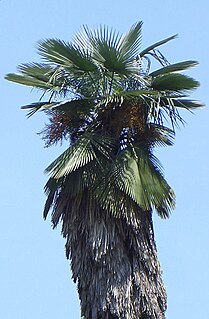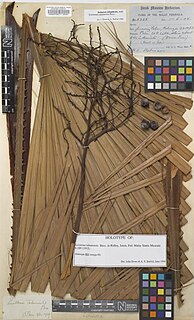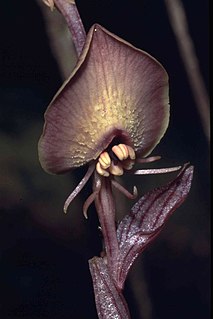
Trachycarpus fortunei, the Chinese windmill palm, windmill palm or Chusan palm, is a species of hardy evergreen palm tree in the family Arecaceae, native to parts of China, Japan, Myanmar and India.

Livistona is a genus of palms, the botanical family Arecaceae, native to southeastern and eastern Asia, Australasia, and the Horn of Africa. They are fan palms, the leaves with an armed petiole terminating in a rounded, costapalmate fan of numerous leaflets.

Odoardo Beccari was an Italian naturalist who discovered the titan arum, the plant with the largest unbranched inflorescence in the world, in Sumatra in 1878. This botanist is denoted by the author abbreviation Becc. when citing a botanical name.

Nepenthes beccariana is a tropical pitcher plant. The species was described in 1908 by John Muirhead Macfarlane based on a specimen collected from the island of Nias, which lies off the western coast of Sumatra. It appears to be closely related to both N. longifolia and N. sumatrana, and the former is possibly a heterotypic synonym of this taxon.

Trachycarpus takil, the Kumaon palm, is a fan palm tree that is endemic to the foothills of the Himalaya in southern Asia.

Livistona australis, the cabbage-tree palm, is a plant species in the family Arecaceae. It is a tall, slender palm growing up to about 25 m in height and 0.35 m diameter. It is crowned with dark, glossy green leaves on petioles 2 m long. It has leaves plaited like a fan; the cabbage of these is small but sweet. In summer it bears flower spikes with sprigs of cream-white flowers. The trees accumulate dead fronds or leaves, which when the plant is in cultivation are often removed by an arborist.

Livistona mariae, also known as the central Australian or red cabbage palm, is a species of flowering plant in the family Arecaceae.

Livistona tahanensis is a species of medium-sized palm tree of the genus Livistona, found on only one mountain top in Pahang, Peninsular Malaysia. In Malay the palm is known as Tahan serdang, or as daun tau.
Borassus heineanus is a species of a large solitary fan palm found only in northern New Guinea, in both Papua New Guinea and Indonesia, where it is threatened by habitat loss.
Dransfieldia is a monotypic genus of flowering plant in the palm family from western New Guinea where the lone species Dransfieldia micrantha grows in dense rain forest. Discovered in 1872, 134 years passed before DNA testing revealed its proper placement. With no close relatives, it is a delicate, pinnate-leaved palm named after John Dransfield, former palm expert at the Kew Royal Botanic Gardens.

Sabal causiarum, commonly known as the Puerto Rico palmetto or Puerto Rican hat palm, is a species of palm which is native to Hispaniola, Puerto Rico, the United States Virgin Islands, and the British Virgin Islands. As its common and scientific names suggest, its leaves are used in the manufacture of "straw" hats.

Sabal maritima, is a species of palm which is native to Jamaica and Cuba.

Cephrenes trichopepla, the yellow palm dart, is a butterfly of the family Hesperiidae. It is found in Australia, Papua and Papua New Guinea. It has recently been recorded from Singapore and Sri Lanka.

Cyrtostachys renda, also known by the common names red sealing wax palm and lipstick palm, is a palm that is native to Thailand, Malaysia, Sumatra and Borneo in Indonesia. It is the only species of the genus Cyrtostachys that can be found to the west of the Wallace Line, the faunal boundary separating the ecozones of Asia and Wallacea. Cyrtostachys renda's name is derived from several words: the Greek prefix κυρτό- (cyrto-) meaning bent or curved, the Greek word σταχυς (stachys) meaning "an ear of grain", and "renda" a Malayan Aboriginal word for palm, which happens to be homonymous to the Portuguese word "renda," meaning income.

Veitchia arecina, commonly known as Montgomery palm, is a species of flowering plant in the family Arecaceae. It grows to between 25' to 35' and has white or yellow blooms.

Pritchardia beccariana, the Kilauea pritchardia, or Beccari's loulu, is a species of palm tree in the genus Pritchardia that is endemic to wet forests on the eastern part of the island of Hawaiʻi, near Hilo.
Heterospathe elegans is a species of flowering plants in the palm family (Arecaceae). It is found in New Guinea.

Butia stolonifera was an oddly growing palm assigned to the genus Butia found only once in Uruguay in the 19th century, but which now is considered to be uncertain as a valid species.
John Leslie Dowe is an Australian botanist who specialises in palms.

Corsia ornata is a species of flowering plant in the genus Corsia of the small family Corsiaceae, part of the monocot order Liliales. They are saprophytes (Myco-heterotrophs), lacking the ability to photosynthesise, being dependent on other organisms for their nutrition. The plant lives underground, sending up purplish stems above ground in order to flower. The leaves are reduced to scales. One of the six petal-like tepals named the labellum, is specialised, being enlarged and hanging protectively over the reproductive organs. It was discovered in New Guinea in 1875, but has since been sighted in Queensland, Australia.
















